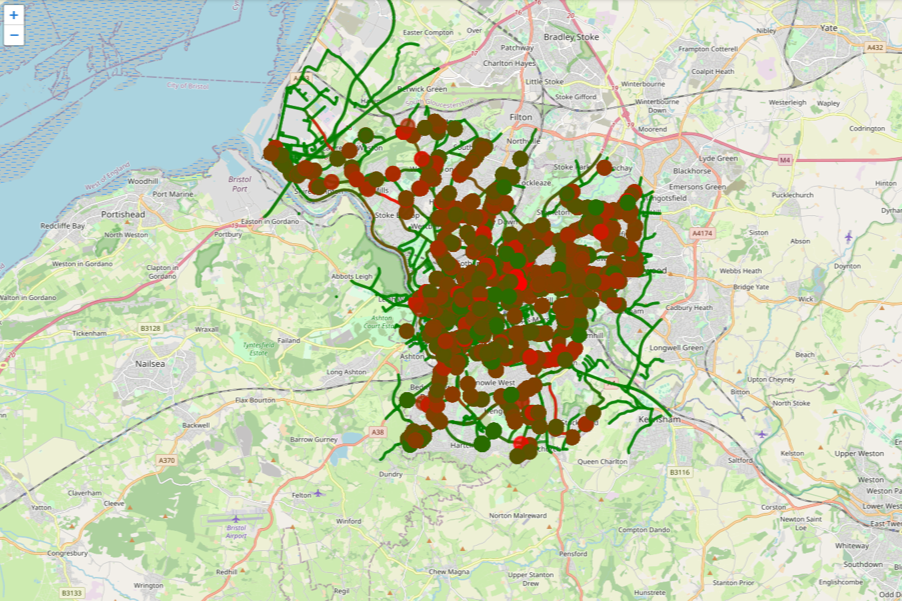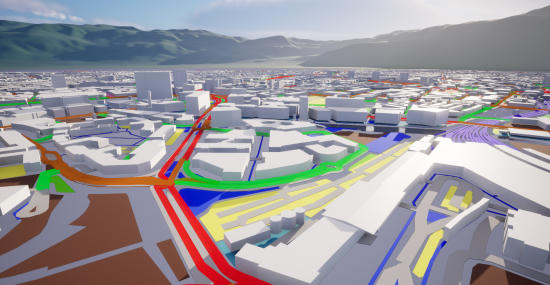How Compass: Engine™ Transforms Decarbonised Transport Planning
Breaking Barriers, Shaping the Future
The Connected Places Catapult funded Slingshot Simulations to develop a use case using their place-based decision intelligence solution, Compass: Engine™, featured in the UK Transport Research and Innovation Board’s Digital Twin Roadmap 2035.
Compass: Engine™ offers unique capabilities to integrate data, models and simulations and rapidly sift a vast array of policy intervention options.
The project demonstrated how Compass: Engine™ can rapidly assess the road-by-road impact on emissions and noise scenarios at a city scale resulting from possible low emission zone interventions– and correlated these to surrounding domestic properties, especially those with lower EPC ratings.
This approach made it possible to holistically develop integrated building regeneration and future mobility strategies and help mitigate unintended impacts.
The Challenge
The rapid advancement of technology – electric vehicles, hydrogen, autonomy and more – combined with an increasingly interdependent set of requirements – environmental, safety, health, etc. – has resulted in a vast and complex set of potential policy intervention scenarios for transport decarbonisation.
Assessing and prioritising the impact of potential interventions requires extensive work, time and costs. The UK Government’s Transforming Infrastructure Performance Roadmap to 2030 identified digital twins as a critical technology to address this. While digital twin technology offers powerful insight and tools, three critical barriers to adoption include:
- High and exponentially growing volumes of siloed and disconnected data;
- Domain expert analytics and simulation tools that typically provide a one-dimensional view, for example, traffic, rather than an integrated, holistic perspective of place;
- Combined, these two factors inhibit the large-scale assessment of a wide range of possible interventions leading to suboptimal outcomes.
A digital skills gap compounds these barriers and delays progress toward achieving decarbonisation and climate resilience targets.
About the Study
The UK’s Transport Research and Innovation Board (TRIB) and the Connected Places Catapult selected Slingshot Simulations’ unique solution to address a use case specific to transport decarbonisation challenges and demonstrate how it could overcome the current barriers to digital twin technology.
The use case focused on a specific question:
In a realistic city region, including a low emissions zone, for a range of potential future electric vehicle (EV) uptake scenarios, what is the local, street level emissions and noise level impact, and how does this correlate to adjacent building EPC ratings?
This question illustrates how digital twins can provide a holistic perspective into potential intervention scenarios by correlating the noise and emissions impact changes with the EPC (Energy Performance Certificate) of affected buildings. This is important as increasing noise and emissions in areas of low domestic EPC ratings can have an unintended negative impact on the local inhabitants as those properties tend to be more porous and have lower sound insulation.
Understanding these possible impacts allows planning authorities to prioritise better, plan and adapt building and housing stock regeneration investments for future scenarios. This study additionally showed how a digital twin could bridge the gap between macro-level policies and local impact.
The Solution
Compass: Engine™, Slingshot Simulations’ place-based decision intelligence solution, provided the following critical capabilities required to address the specific use case and some of the broader barriers to digital twin adoption:
Prepopulated with the place-based data required, eliminating the hours and days of personal time previously required;
Embedded models and simulations for carbon conversion and transport that are accessible by the non-domain expert;
Rapid assessment of multiple policy intervention options using advanced data science to enable the large-scale sifting of policy intervention options
Slingshot Simulations delivered the solution in three stages: the digital model, the digital shadow and the digital twin. The results of each step are described in detail below.
Stage 1: Digital Model
As one of the UK’s most congested cities outside of London, Slingshot Simulations selected Bristol as the region of study. The Compass: Engine™ platform automatically created a 2D digital model of Bristol.
The Bristol digital model in Figure 1 highlights Compass: Engine’s™ advanced, dynamic and easy-to-use interface for all stakeholders involved.


Figure 1: Example of the Digital Model of Bristol (Model Extents and Zoomed-in View).
Stage 2: Digital Shadow
The digital shadow was automatically generated from the digital model and included the relevant prepopulated key data sets to address the use case question. These included census data (including origin-destination), land use data and building EPC ratings.


Figure 2: Examples of the Digital Shadow of Bristol Highlighting Select Building EPC Data (Model Extents and Zoomed-in View).
Stage 3: Digital Twin
Compass: Engine™ includes a feature to build and run traffic simulations from the base data provided. For this use case, Slingshot Simulations collaborated with an expert traffic simulation company, Goleyo, to integrate an existing traffic flow model (built with SUMO software) into the extended digital shadow for the study’s region.
Slingshot Simulations used census-based origin-destination data, calibrated traffic count data from ANPR systems and Google mobility data for travel times to generate a realistic traffic flow. Using this base model, four EV adoption scenarios were simulated (i.e., 0%, 20%, 50% and 100% EV uptake) along with an analysis of the emission and noise results.
The following examples highlight the differences between the two scenarios: 0% uptake (left image) and 50% uptake (right image) in EVs. The results demonstrated how actionable insights in Compass: Engine™ can bridge the gap between real-world data, analytics, simulations and the most practical interventions available.


Figure 3: Examples of the Digital Twin of Bristol Highlighting The Integration of Traffic Simulation and EPC Data (Zoomed-in View). CO2 Emissions with 0% EVs (Left); 50% EVs (Right).
Improving Engagement Across Stakeholders
Using a digital twin generates significant technical and economic benefits and enables the engagement of a broader range of stakeholders compared to static reports and documentation. In the demonstration project, Slingshot Simulations expanded the digital twin solution to create an interactive 3D representation of the study region.



Figure 4: Examples of the Digital Twin 3D Interactive Model of the Region (Left: Digital Model; Middle: Digital Shadow with EPC data; Right: Digital Twin with Predicted Noise Levels).
The Results
The use case described in this case study is part of the Transport Research and Innovation Board’s Digital Twin Roadmap 2035.
The roadmap vision is to enable a trusted ecosystem of connected digital twins for multi-modal UK transport networks. Using digital twin technology will facilitate effective decision-making to optimise solutions and deliver efficient, safe, and environmentally conscious mobility for people and goods.
In addition, this use case demonstrated that digital twins can:
- Be an essential tool for engagement and alignment around common strategic priorities;
- Provide an outline of the activities and building blocks to deliver the vision;
- Enable improved facilitation and coordination across TRIB member bodies and other broader stakeholders in future investment in digital twinning research and innovation, connected digital twins and cyber-physical infrastructure;
- Enable a socio-environmental and technical change in the transport sector.
If you want to learn more about this use case, visit TRIB for more information.
Get in Touch
If you’d like to know more about Compass: Engine™ , contact our team and we will be in touch shortly.
